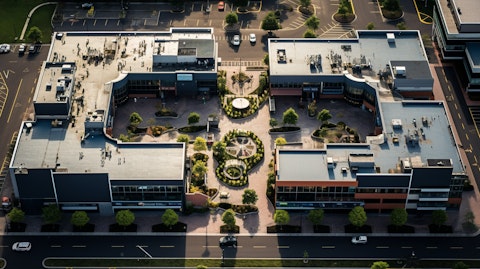Regency Centers Corporation (NASDAQ:REG) Q3 2023 Earnings Call Transcript November 3, 2023
Operator: Hello, and welcome to the Regency Centers Corporation Third Quarter 2023 Earnings Call and Webcast. [Operator Instructions] As a reminder, this conference is being recorded. It’s now my pleasure to turn the call over to Christy McElroy, Senior Vice President, Capital Markets. Please go ahead, Christy.
Christy McElroy : Good morning, and welcome to Regency Centers’ third quarter 2023 earnings conference call. Joining me today are Lisa Palmer, President and Chief Executive Officer; Mike Mas, Chief Financial Officer; Alan Roth, EVP National Property Operations and East Region President; and Nick Wibbenmeyer, EVP and West Region President. As a reminder, today’s discussion may contain forward-looking statements about the company’s views of future business and financial performance, including forward earnings guidance and future market conditions. These are based on management’s current beliefs and expectations and are subject to various risks and uncertainties. It’s possible that actual results may differ materially from those suggested by these forward-looking statements we may make.
Factors and risks that could cause actual results to differ materially from these statements may be included in our presentation today and are described in more detail in our filings with the SEC, specifically our most recent Form 10-K and 10-Q filings. In our discussion today, we will also reference certain non-GAAP financial measures. The comparable GAAP financial measures are included in this quarter’s earnings materials, which are posted on our Investor Relations website. Please note that we have also posted a presentation on our website with additional information, including disclosures related to forward earnings guidance. Our caution on forward-looking statements also applies to the presentation materials. Lisa?
Lisa Palmer : Thank you, Christy, and good morning, everyone. We had another strong quarter of operating results, supported by continued positive momentum in our business Tenant demand remains really healthy and consistent, and this is evident in the strength of our rent growth and our ability to further increase leased occupancy despite elevated bankruptcies. And you’re going to hear a lot more about this from Alan in just a few minutes. We continue to drive success within our development program as well. This is reflected in the leasing progress that we’ve made across our in-process pipeline as well as our significant volume of project starts year-to-date. Development is a core competency of our company. And as you heard me say before, I believe we have the best national platform in the business.
We have proven our ability to create meaningful value and earnings accretion over time and we remain well positioned to reach our targeted annual pace of $200 million to $250 million of redevelopment and development spend annually. On the transaction side, we were proud to close our merger with Urstadt Biddle in mid-August. And since then, we made significant headway integrating the assets into our platform and welcoming our new Regency team members. Our short time with the portfolio and the people has only served to reinforce our confidence in the combination of our 2 great companies. We also recently acquired 2 shopping centers. Nick will discuss these in more detail. But despite a pretty thin transaction market, I’m really proud that we were able to find some higher total return needles in the haystack.
So turning to the macroeconomic environment. Yes, we continue to see positive trends. We are seeing in real time the spending power of the consumer in our trade areas. This is evident in the solid sales performance for our tenants and for traffic to our centers. And while a deceleration perhaps has been expected by many, we are not seeing it. We remain really encouraged by the structural supply-demand trends that are supporting our business today. Our tenants continue to invest in brick-and-mortar stores that are profitable as a last mile distribution channel, and our suburban trade areas continue to thrive. And while we continue to create value through ground-up development, overall, there is very little new retail space being added in the U.S., supporting the value and scarcity of existing space.
That said, we do acknowledge that increased interest rates and significantly higher borrowing costs in the recent months do create uncertainty. First is the future to our earnings from refinancing next year’s debt maturities. Our intentional strategy of maintaining low leverage and a ladder debt maturity schedule do act as mitigants to changes in rates, but we still expect to see an impact in 2024. The bottom line, though, is that in today’s uncertain world, the one thing that we — that I am certain about is that Regency remains well positioned. And this is a direct result of many attributes, one of which is our intentional portfolio composition. We believe the quality of our grocery-anchored neighborhood and community centers and the strength and demographics of our trade areas support durability of occupancy and create a wide buffer to insulate against potential economic impacts to our tenants and to our customers.
And another attribute is our strong balance sheet and liquidity position, including our significant free cash flow. With this, we have flexibility in our capital allocation decision-making and an ability to self-fund and maintain consistency in our value creation pipeline through economic cycles. And importantly, we can also continue to play offense and be opportunistic. All of this is what’s enabled us to maintain our dividend through the pandemic and raised it again this quarter by another 3%. We’re now up 15% from 2019. Alan?
Alan Roth : Thank you, Lisa, and good morning, everyone. We continue to experience a very healthy retail environment as demonstrated by another quarter of strong operating results and demand for space in our centers remained robust. We increased our same-property lease rate by 20 basis points in the third quarter, even when factoring in roughly 25 basis points of impact from bankruptcy-related move-outs, primarily attributed to the remaining Bed Bath locations. Our shop leasing activity has been at a record pace over the last several quarters, including above-average retention rates, resulting in another 50 basis point increase in our shop lease rate in the third quarter to a near record high of 93.2%. We were also able to generate solid re-leasing spreads again this quarter, 9% cash spread on a blended basis, including spreads of more than 20% on new leasing.
Our straight-line rent spreads were above 17%, reflecting our keen focus on sustainable annual growth and our ability to consistently achieve contractual rent steps in the majority of our leases with annual steps often 3% or higher on our shop deals. Leasing progress continues to drive strength in our same property base rent growth which was more than 3% in the third quarter and remains our largest and most important contributor to same-property NOI growth. We continue to replenish our executed SNO pipeline as tenants open today, representing more than $36 million of annual incremental base rent, and our leasing pipelines remain full, supported by continued depth and negotiation activity. We are seeing strength in tenant demand across all of our regions and from a range of categories, including grocers, off-price, medical, restaurants, fitness, and pet services.
In fact, at our former Bed Bath location, we’ve had one of the fastest absorption rates in recent memory as it relates to a material anchor liquidation. And while most of the new leases won’t commence until the second half of 2024 or later, half of our vacated spaces have been executed with new tenants and the remainder of the space is in active negotiation. Based on our activity backfilling the rejected leases, we now expect rent spreads above 30% on average, exceeding our original projections. In regard to the recent Rite Aid bankruptcy filing, we have 22 locations in total, representing 50 basis points of ABR. We had one store that was already dark, which was part of the initial rejection list and one more on the going out of business sale list.

We are early in the process of this bankruptcy proceeding, but we feel really good about our exposure and the quality of our locations as a result of productive sales or below market rents. We know that tenant bankruptcies are a normal part of our business. And importantly, our high-quality shopping centers are well positioned to grow through it with better merchants, often at higher rents and driving greater traffic to our centers. Lastly, as Lisa mentioned, the integration process with Urstadt Biddle has been progressing successfully. We’re excited to welcome our new Regency team members in the Northeast and bring these high-quality assets into our portfolio where we are already having tremendous success on the leasing front. With this transaction, we further strengthened our best-in-class operating platform.
Nick?
Nicholas Wibbenmeyer : Thank you, Alan. Good morning, everyone. We had another productive quarter for development and redevelopment activity, increasing our starts year-to-date to $210 million. One of our Q3 starts is the $15 million redevelopment of Circle Marina Center in Southern California. Acquired in 2019 with the intention of redeveloping the center, the project includes the replacement of the existing Staples box with the new Sprouts Farmers Market in addition to extensive site improvements of the façade renovation, enhancements to the shop space in common areas. We continue to make great progress executing on our $440 million in-process pipeline and have seen tremendous activity on these projects, currently over 84% leased with blended returns of more than 8%.
As an example, at our ground-up Glenwood Green project in Old Bridge, New Jersey, the target in ShopRite buildings are substantially complete and on schedule to open this coming spring. Leasing momentum has been strong, we are now 92% preleased with a great tenant lineup, including Wawa, Shake Shack, Duck Donuts, Paris Baguette and Evolve Med Spa. Now turning to acquisitions. While private transaction market activity remains then, we were able to source 2 unique opportunities to allocate capital and higher IRRs within our targeted trade areas. In September, we acquired Old Town Square within one of our joint venture partnerships, a high-performing center in dense Chicago neighborhood anchored by Jewel-Osco, the recent top grocer. This is a near urban asset with a suburban file layout located in a trade area with over 500,000 residents in a 3-mile radius.
It is widely regarded as one of the premier grocery centers in the Chicago area. In October, we closed on the acquisition of Nohl Plaza in Orange County, California. This Vons-anchored center provides a near-term value-add opportunity after redevelopment, resulting in an estimated IRR that will exceed 10%. As we look ahead, our teams remain focused on building our value creation pipeline, and we see the opportunity to start more than $1 billion of development and redevelopment projects over the next 5 years. Demand is strong among grocers and other retailers looking to grow their footprints in high-quality centers within attractive trade areas, coupled with the relative lack of new supply. We have the best development team in the business, and we continue to see a compelling opportunity to capitalize on this incremental demand at a time when we are one of the only developers with the capability to fund projects and execute.
And as we’ve discussed many times before, we have the ability to self-fund our growth pipeline without raising any incremental equity with free cash flow north of $160 million annually. We are sourcing these projects through the redevelopment of our existing assets, we’re acquiring redevelopment opportunities like Circle Marina and Nohl Plaza, and we’re partnering with landowners and expanding grocers as we seek new ground-up development projects. It’s important to note, especially in this environment, that as we evaluate investment opportunities, our teams remain cognizant of today’s higher cost of capital, and we are focused on ensuring appropriate risk-adjusted returns. It also gives us comfort that for the type of assets we are building and redeveloping, we meaningfully derisk our projects ahead of putting a shovel on the ground with significant pre-leasing, entitlements and bids for the majority of our cost in hand.
Overall, we are excited about the investments we’ve made and by the opportunities we see ahead of us. Mike?
Michael Mas : Thank you, Nick, and good morning, everyone. I’ll start with highlights from our third quarter results, walk through a few changes to our guidance for the balance of this year, provide some comments on 2024 and finish by touching base on our balance sheet position. We reported third quarter NAREIT FFO of $1.02 per share, which was impacted by $0.01 of EDP merger transition expenses and core operating earnings of $0.97 per share. We grew same-property NOI by 2.9% in the third quarter, excluding the impact of COVID period reserve collections and termination fees. Importantly, as Alan mentioned, the largest component of growth continues to be base ramp, contributing 320 basis points to our NOI growth rate in the quarter, driven by the combination of embedded rent steps, higher commenced occupancy and redevelopments coming online.
Turning to our revised current year guidance, I’ll refer you to the detail on Slides 5 through 7 in our earnings presentation. Driven by another strong quarter of new leasing and continued high tenant retention, we’ve eliminated the bottom end of our prior same-property NOI growth range and are now guiding to finish the year at about 3.5%, excluding COVID period reserve collections and termination fees. We have also raised our per share core operating earnings guidance by $0.03 at the midpoint, driven primarily by the upward revision to same-property NOI, the expected accretion from the Urstadt Biddle transaction and changes to our acquisition and disposition assumptions. Comparably, we only raised our NAREIT FFO per share range by $0.01 primarily due to the offsetting impact of forecasted merger transition costs.
As we all start to plan for 2024 on Slide 8 of our earnings presentation, we provided some forward-looking considerations of certain nonrecurring items, including COVID period reserve collections and noncash impacts as well as summary details on the Urstadt Biddle merger accretion and related continuing transition expenses. While I won’t belabor the details on today’s call, we trust you’ll find this disclosure very helpful, and we highly recommend you review it as we recognize there are many moving pieces to consider heading into next year. Additionally, given the higher interest rate environment and potential future refinancing impact, we want to provide as much transparency as possible as to how we are thinking about our financing plans next year.
These plans include an unsecured bond offering in the first half of 2024, sized in the $400 million to $450 million range with proceeds used to refinance scheduled debt maturities and to reduce our balances on our credit facility. We are proud of the strength of our balance sheet, which has been an intentional and foundational strategy of our company and is particularly important in times like today when for others, access to capital is more limited and pricing more volatile. Importantly, as Lisa mentioned, we are not immune to the adverse impact of higher rates but our overall low leverage, combined with a well-laddered maturity schedule helps mitigate the financing impacts for Regency in any given year. We feature one of the strongest balance sheets in the REIT sector with our leverage remaining at the low end of our targeted range of 5x to 5.5x debt-to-EBITDA.
We continue to generate significant free cash flow, expected to be north of $160 million this year, self-funding our growing investments pipeline, and we have access to meaningful liquidity through our $1.25 billion line of credit. Given this foundation, we remain confidently on our front foot as we move forward. With that, we’re happy to take your questions.
See also 12 Best Mid-Cap Dividend Stocks To Buy Now and 11 Best Stocks to Buy for Income.
Q&A Session
Follow Regency Centers Corp
Follow Regency Centers Corp
Operator: [Operator Instructions] Our first question today is coming from Michael Goldsmith from UBS.
Michael Goldsmith : Can we just talk quickly about the moving pieces of the Urstadt Biddle transaction, any impact on the guidance next year and then also next year? It seems like the deal is a headwind in NAREIT FFO this year. And so maybe the fourth quarter FFO number isn’t the best run rate for next year, but it’s also positive in core operating earnings this year and next year, it should be a tailwind to both FFO and core operating earnings. Is that right, Mike?
Michael Mas : I would encourage everyone to look at Page 8 of the supplement that we put out with our guidance considerations for next year. I think that would be very helpful. But I think you’ve actually outlined it pretty well in your question. It will be a positive contribution from a core perspective at the level of about 1.5% accretion. And we’ve given those components there on the slide. It’s basically worth an incremental $0.04 to $0.05 per share in ’24 versus’ 23 and then the complexity that you’re outlining would be in our NAREIT FFO line item as it relates to merger transition costs. We will have — we’ll end this year, we estimate in the $5 million area large portion of that coming through in the fourth quarter of this year.
And then we are anticipating the trailing $7 million of those same expenses on a transition basis leaking into 2024. From a timing perspective there, I think it’s fair to just pro rata spread of that $7 million through the year next year.
Lisa Palmer : And I can’t help but take this opportunity. I think it’s a great opportunity to just reiterate what I said in my prepared remarks. It’s been a short time. I mean we just closed in mid-August, but the integration and bringing the priorities and the people into Regency in that short period of time. It’s just — it has just really validated that this is a great transaction and a combination of 2 really good companies, and we’re excited about it.
Michael Mas : One last piece. Just to confirm, many have asked us about the noncash impacts from the purchase accounting, just — it’s in our materials, but I just want to confirm that there is no impact in 2024 as the revenues — the noncash revenues are offsetting the noncash expenses.
Michael Goldsmith : And my follow-up is on the lease escalators. It seems as though that’s the lease of our same property NOI algorithm, it seems like you’re getting 3% plus. I guess how quickly can in an elevated escalator environment, you’ve got the most exposure to small shop? How quickly can you kind of cycle too cycle through some of the older leases, which may have lower escalators and get these tenants on to higher escalators so that it slowly lifts your overall earnings growth or same-property NOI algorithm?
Alan Roth : Yes, Michael, this is Alan. What I would say is that is a keen focus and has been for quite some time. And as you noted, I don’t think you said the number, but 75% of our shop deal did have 3% or higher escalators and approximately 95% of our deals had escalators. So the team is constantly when given the opportunity to have a of this embedded rent step opportunity, we are implementing it. And so certainly, a keen focus.
Operator: Next question is coming from Juan Sanabria from BMO Capital Markets.
Eric Borden : It’s Eric on for Juan. Maybe just starting with Old Town Squares, I just want to talk about — maybe you could talk about the back story and maybe the opportunity set within the asset. And then is this maybe a potential indication to increase your presence into Illinois and potential other Midwest markets?
Nicholas Wibbenmeyer : Eric, this is Nick. I appreciate the question. So starting off with Old Town per your question, yes, it’s an asset we’ve been targeting for quite some time to have the ability to have a suburban layout and a near urban environment with a really high-quality grocer. And we’ve tracked that asset for so probably over a decade and just seen it perform year in and year out. And so it was 1 we were excited to have the opportunity to participate in the bid process. It was ultimately owned by an institutional owner that did have an end of their life to that whole period is our understanding, and so they were looking to liquidate it. And on the flip side, once we got control of it, one of our long-standing institutional partners that we’ve been partners with for nearly 20 years, did have the opportunity through our rotation to take an 80% stake and they exercise an opportunity given they were excited about the real estate as well.
And so we were happy to get that one locked up and close this quarter. In terms of your question on the Midwest, as you know, we’re focused in all of our major markets that we have offices. So we are looking for those needles in the haystack. And I think the analogy I heard this week, and I kind of like it is instead of the normal deal flow, there’s drips of water out there. And so we are evaluating each of the drips of water in all of the major markets that we do business in. and the ones that, as we’ve always said, are equally accretive to our quality and growth and/or and accretive to earnings, we’re going to act on. We have the ability to act on. And so whether it be in the Midwest or the coastal markets, we’re focused on investing our capital where it makes sense.
Eric Borden : Okay. That’s helpful. And maybe one on the SNO pipeline. Of the $36 million, how much is that related to Bed Bath? And then how should we think about the cadence that coming online through ’23 and ’24?
Michael Mas : Eric, $1.5 million of that $36 million is Bed Bath. I’ll add to this. Interestingly, we did add $3 million of UBP portfolio SNO pipeline to that number as well in the quarter. And from a cadence perspective, about 80% of that pipeline will come online through the end of next year.
Operator: Next question today is coming from Lizzy Doykan from Bank of America.
Lizzy Doykan: I just wanted to follow up on the cap rate that we closed on for the Chicago asset and maybe if this is an indication for where you see cap rates trending for quality grocery-anchored centers today? And then separately, if you could confirm the pricing on Nohl Plaza. I know that deal is quite different, given the redevelopment opportunity, but would love to hear more of the back story on that as well.
Lisa Palmer : I’ll take the first part and then I’ll pass it to Nick for Nohl Plaza. I love Nick’s analogy. I actually didn’t hear that this week, and we were together. So I’m not certain where he heard it. But there really are drips of water and not deal flow. So it’s really difficult to say that the cap rate on Chicago is a read-through to cap rates. We’re there’s– the transaction market is still just really in. And we did have — we think of it — and I said it in my prepared remarks, really is more of a needle in a haystack. The most important thing, and Mike said this, and you’ve heard me say it many times, we generate a significant amount of free cash flow and we have that cash flow prioritized to go through our development and our redevelopments.



